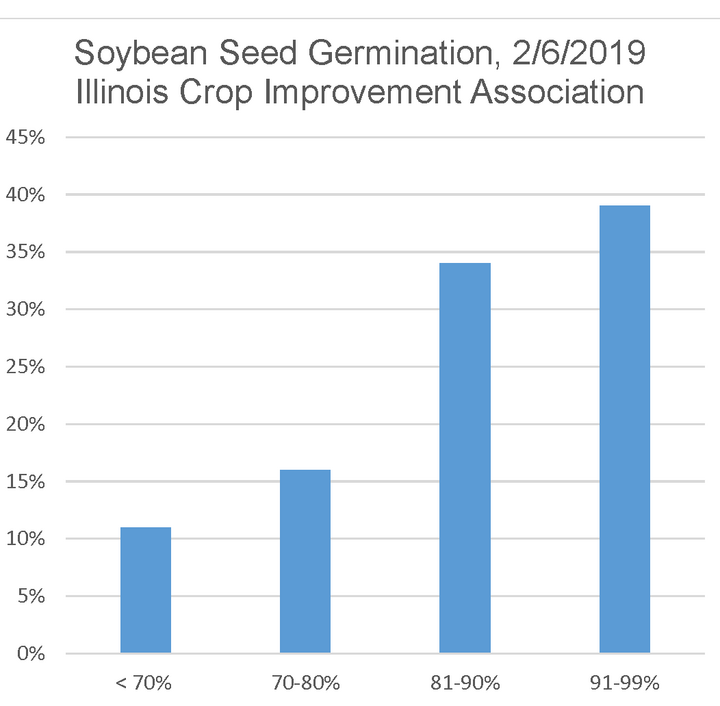
The Illinois Crop Improvement Association released data from their 2019 germination tests indicating the percentage of lots tested in various germination ranges as of February 6. (The NCIA has conducted 28-30 germination tests on soybeans and will be conducting the majority of its tests in the next four weeks.)
Some new crop soybean seed being tested by the Nebraska Crop Improvement Association is falling below the normal germination rate. While a few lots came in at or above 95% germination, results are averaging in the mid 80% range. Growers are urged to check the germination rate for their soybean seed and adjust planting rate accordingly and use fungicide treatments under certain circumstances. Seed treatment fungicides might be recommended when growers are planting early into cold soils or have had chronic problems with seedling diseases.
In a typical year, soybean seed lots tested by the Nebraska Crop Improvement Association (NCIA) range from 88% to 98% germination. This year samples ranged from 43% to 98% germination. The minimum germination for certified soybean seed is 80%, as set by the Association of Official Seed Certifying Agencies (AOSCA). The Nebraska Department of Agriculture has set a minimum germination standard of 75% for soybeans.
In uncleaned samples submitted to NCIA there were a lot of dead, moldy seeds this year. These were cleaned out before germination testing, similar to what would happen in commercial seed production.
Concerns over soybean seed quality issues are widespread across the US production area due to an unusually wet fall that delayed harvest in seed-producing areas of Iowa, Illinois, and Indiana, the sources for much of Nebraska’s seed. Wet fall conditions contributed to the development of several seed diseases: Phomopsis seed decay and purple seed stain. In fall 2018 purple seed stain was reported at above-normal levels in Nebraska. (There are no known sources of resistance for purple seed stain.) NCIA testing has shown little or no reduction in germination in purple stained seed in its tests this year.
What You Can Do
If the germination rate for your seed is lower than normal, consider adding one or more fungicide seed treatments and increasing your seeding rate. Various seed treatment classes and active ingredients do not work equally well against all pathogens. Thus, it’s important to understand which disease(s) have been or may be problematic in your fields and select products or a diverse combination from multiple fungicide classes.
Efficacy ratings are provided for soybean seed treatments in the 2019 Guide for Weed, Disease, and Insect Management in Nebraska on page 255, including for Phomopsis seed decay. This efficacy table was developed by university plant pathologists from throughout the US soybean production area. Tables on the subsequent pages (256-257) list products by fungicide class or mixed modes of action. You can also view these soybean seed fungicide tables, excerpted from the guide, online.
A fungicide treatment won’t improve germination of dying or dead seeds, but it can help protect seedlings under stress and thus help ensure a better stand. A fungicide application should be considered for soybean, especially when the seed germination rate is below normal, you’re planting early into cold soils that may delay germination, or you’re reducing your soybean seeding rate. This earlier CropWatch article addresses what to consider when deciding whether to treat seed.
With lower germination rates, how much should the seeding rate be increased? If you’re shooting for a 120,000 plant-per-acre stand, and the germination rate is 80% rather than the 90% you usually plant, increase the seeding rate by the relative difference. In this example, by 10%. A lot of things can kill your stand after emergence and you don’t want to short change potential yield early in the season.
Insecticide seed treatments are not warranted in response to expected low germination, but may be warranted for early-planted soybean in areas where bean leaf beetle feeding might be expected.
Growers also may want to have any seed they’ve stored on-farm over the winter tested again to determine whether storage conditions may have further affected seed quality. Seed molds can die in cool, dry conditions or increase in wet conditions.
Each spring NCIA tests 500 seed samples for the Nebraska Department of Agriculture to see if germination falls within an allowable range of that stated on the seed label. (These tests include all crops plus bird seed, horticulture seed, etc., sold in the state.) They also conduct germination tests for seed companies and for individual growers. In these recent tests, germination of fungicide-treated seed was slightly higher than non-treated seed.
Additional Resources
Soybean Seed Quality Considerations for 2019, Carl Bradley, University of Kentucky; Daren Mueller, Iowa State University; Damon Smith, University of Wisconsin-Madison; Shawn Conley, University of Wisconsin-Madison; and Kiersten Wise, University of Kentucky. Crop Protection Network, Feb. 6, 2019.
Soybean Quality Issues in 2019, Illinois Field Crop Disease.

